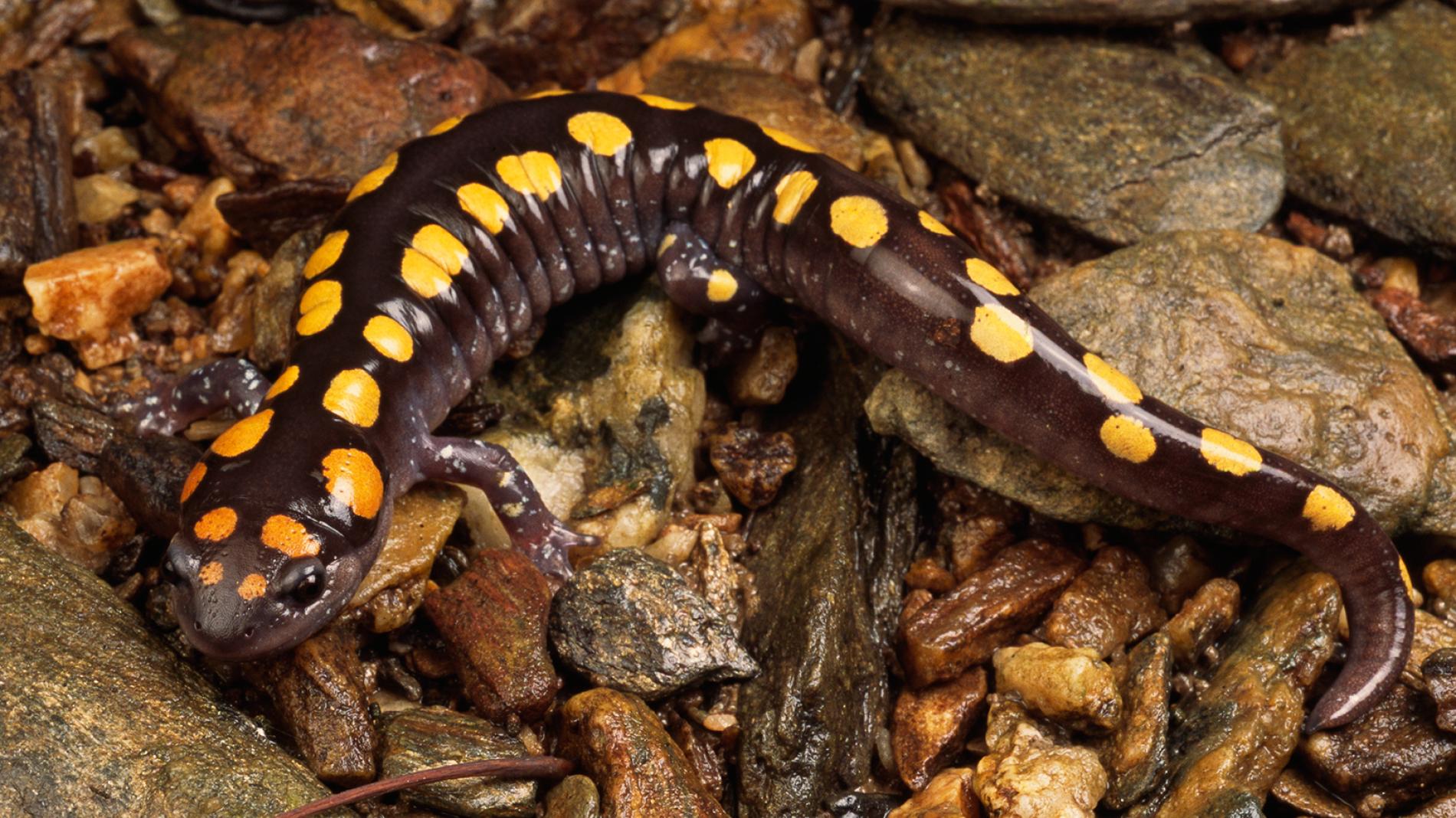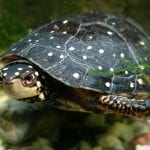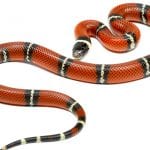Scientific Facts
| Common Name | Spotted Salamander |
| Scientific Name | Ambystoma maculatum |
| Type | Amphibians |
| Geographical Range | Eastern North America, Gaspé Peninsula west, northern shore of Lake Superior, southern Georgia, eastern Texas to Nova Scotia |
| Habitat | Under rocks, logs or in burrows, in the forests along riversides and ponds |
| Size | 7 inches |
| Weight | 12.84 grams |
| Lifespan | Up to 20-30 years |
| Diet | Carnivore |
| Color | Black, dark grey, dark green, or blueish-black |
| Habitat | Under rocks, logs or in burrows, in the forests along riversides and ponds |
| Color | Black, dark grey, dark green, or blueish-black |
Physical Description
The Spotted Salamander or also known as the Yellow Spotted Salamander, has got its name from the two rows of orange and yellow spots that are spread all throughout its body from head to tail and it may range from 24-25 spots that are arranged in two irregular rows. It is hard for them to camouflage because of their main colors which are black, but there are some salamanders that are colored dark grey, dark green, or blueish-black. Compared to other salamanders, what makes them unique is their stout body and rounded snout. It seems that their head is swelling because of their bulky looks. They have large legs with a varying number of toes, sometimes 4 or 5 in each Spotted Salamander.
They have a long and slender body with smooth and moist skin. Not all Spotted Salamanders have gills and lungs, some only have gills, and some only have lungs. They breathe through their skin. If you would see them, it looks like they are slimy and has cold skin because of their wet appearance.
Geographical Range
They can be seen mostly in the parts of eastern North America and extends their range from the Gaspé Peninsula west to the northern shore of Lake Superior to southern Georgia, eastern Texas to Nova Scotia. They are also prevalent in the deciduous forests of Eastern Canada to the eastern and midwestern parts of the United States.
Habitat
Spotted Salamanders are secretive because they spend most of their life span hiding in different spots in the forest, such as under rocks, logs or in the burrows of other mammals or reptiles. They are most abundant in the forests along riversides, ponds or tunnels below the ground as long as the environment is a bit damp. However, during the summer season, when the environment is dry and humid, they would usually stay in ponds together with other salamanders to mate.
Behavior and Temperament
Spotted Salamanders are considered fossorial, or they spend most of their time hiding underground. They only come out after the rain, after the winter season, or after they have hibernated just in time for the mating season. When they are threatened, they will secrete a noxious and milky toxin coming from the glands of their heads and tails trying to dissuade their predator, this toxin that they release has jelly and sticky consistency rather than watery.
Spotted Salamanders communicate with another salamander by using their senses, such as sight, touch, and smell. They rarely communicate unless they are threatened or being attacked. They have a great adaptation technique because of their regenerative abilities that when one part of their bodies such as legs, tail, parts of the brain, head or organs is dismantled or cut it can still grow and function well.
Breeding and Reproduction
The breeding process would usually take place at the end of winter after the ground defrost. Adults Spotted Salamander would migrate into freshwater with males arriving first. The population of males is greater compared to females in the pool; that is why they compete by means of bumping, nosing, and rubbing each other. Reproduction takes place when the males produce droplets of sperm that females take in to fertilize eggs.
The males can fertilize several females, and females can also take sperm from different males. The females lay eggs that range between 100-300 eggs which are laid underwater and attaching it into different submerged objects.
Life Cycle
Spotted Salamanders undergo the metamorphosis process wherein they started to be a water creature to one that would spend most of its time in the land. They have a quite long incubation period compared to other salamanders that may take 4-7 weeks to hatch depending on the temperature of the water. The larvae are about 12-13 mm long, with feathery gills and legs only present.
After a week of transformation, the yellow and orange spots will be visible. Once their tail becomes thicker and their external gills fall off it means that they are now about to enter the juvenile stage and they can now leave the pond. After 2-3 years they mature into adults that can reproduce.
Eating Habits
Spotted Salamanders are carnivores; their diet includes worms, slugs, spiders, millipedes, and insects. They tend to eat all living creatures if it is smaller than them. Adults would use their sticky tongues to catch their prey that is laid on the floor. Their larvae are also aggressive predators that eat anything that is small or those that are dominated by zooplankton, they also eat salamander species especially, if there is food scarcity. They are known as nocturnal where they only come out at night to hunt food.
Size and Weight
They are considered as the biggest salamanders with an average size of about 20–25 cm (5.9–9.8 in) long. Female Spotted Salamanders tend to grow bigger than males.
Lifespan
Spotted Salamanders can live up to 20 years and above. In the recent research conducted, there is a 30-year old Spotted Salamander that lives up to the present, and it is in captivity in the USA. They have a total of 4 life cycles: egg, larva, juvenile, and adult.
The Shedding Process
Like other animals such as snakes and lizards, Spotted Salamander also periodically replace their skin cells throughout their lifespan. This is a normal and healthy process, but since they are nocturnal and secretive, this process is not commonly seen. When they shed, they make sure that they burrow themselves. You may notice that before it shed its skin, they would spend most of their time hiding in damp surfaces, and some even have lost appetite for food. Their way of shedding is quite different because they help remove their old skin by making use of their rear legs to push it forward.
They also see their old skin appealing; that is why they eat it getting the nutrients that are on it. If you notice that your salamander is having a hard time shedding its skin, there is a possibility that it has something to do with the moisture level. If it happens, prepare a separate container that has moist soil or moss and let it stay there for a couple of hours or until the skin has completely removed. In this process, every time you would handle your pet, make sure to use gloves so that the oil in your skin won’t get in touch with the fragile skin that may cause some irritations to them.
Common Illness and Diseases
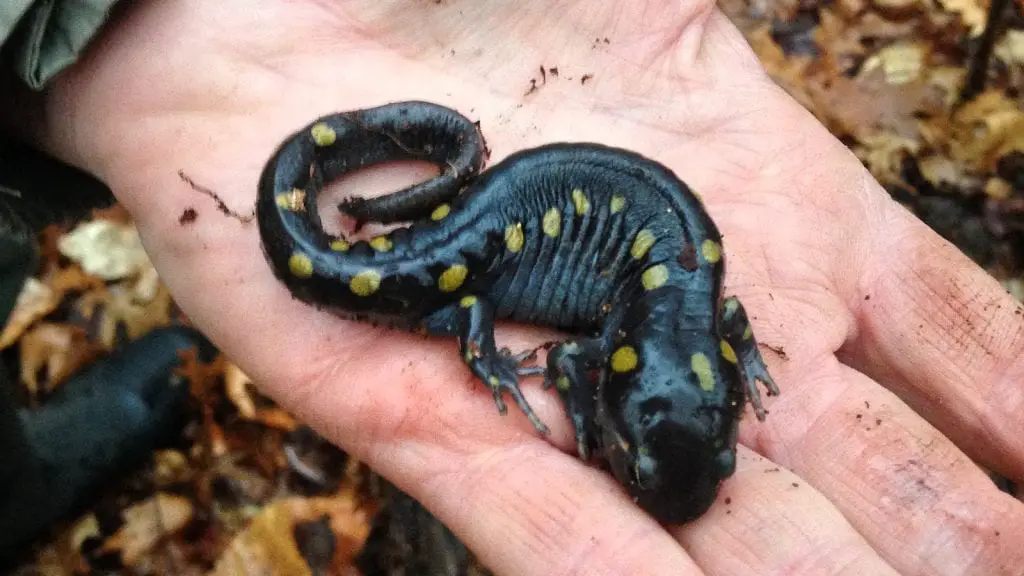
Chytridiomycosis
This fungal disease usually invades those amphibians that are associated with bodies of water, such as streams, ponds, and soaks. This is triggered by high temperatures that invade the surface of their skin. The skin of Spotted Salamander is active when it comes to the regulation of respiration and absorption of water and electrolytes when they are infected with this disease the normal functioning of their body is disrupted causing their death because of osmotic balance. This is one of the most devastating threats to all amphibians.
Batrachochytrium salamandrivorans
This disease is responsible for the decrease in populations of salamander in the Netherlands and Belgium. It impacts the epidermal cells of the skin, causing skin ulcerations. Your salamander will have abnormal behavior and body posture. Within 2-3 weeks of exposure to this disease, expect your salamander will die if not treated properly. It impacts the epidermal cells of the skin, causing skin ulcerations.
Batrachochytrium dendrobatidis
This is characterized as the thickening of the part of the skin, which is the stratum corneum caused by the spore containing bodies within the keratinized cells. The normal thickness of the skin’s layers is about 2µm to 5µm, but when the salamander is infected with this disease the layer of the skin would reach up to 60 µm. This fungus also infects their mouthparts that makes it hard for them to eat. This is also fatal to yellow-spotted salamanders because it weakens their immune system.
Ranavirus
This is an ailment that causes the mortality of salamanders in just a short span of time. The pathogens cause severe bleeding and hemorrhages, especially of their organs. The suspected root cause of this ailment is the unsanitary transportation of these amphibians. Aside from hemorrhages, some signs that your salamander is impacted with ranavirus are redness of the skin, drowsiness, abnormal wasting, breakdown of the limbs, and eye problems.
Preventing Illnesses
These common diseases and illnesses that impacts Spotted Salamander are usually due to virus and bacteria that multiplied brought by the environment. There are some diseases that can easily can in contact with your pet; that is why if you have already taken it into captivity, it is not advisable to take it outside. Make sure that it is in a safe enclosure that is clean and sanitized so that it is not prone to getting these diseases.
Aside from making sure that your pet’s housing is sanitized and clean, it is also advisable to always wash your hands before and after handling them. If it is not necessary to hold them, it is better to just observe them so as not to irritate their skin as well. If you see any unusual signs in their behavior or in their physical appearance, it means that they are sick, so immediately ask for medical attention.
Captive Breeding
Spotted Salamanders are good pets for captivity because they are not aggressive to humans and that they can be maintained easily as long as you provide their basic needs such as housing with accessories that mimics their natural environment, water, food, and proper lighting and temperature. Because of the degradation of their natural habitats, some experts would suggest to take it into captive breeding so as to preserve its genetics.
It is good to take a pair of salamanders, one male, and one female so that they can multiply. If you preferred to breed your own, just make sure to always check on the temperature, the acidity level of the water and substrate used because this will greatly affect their reproductive activity. Also make sure that their environment consists of land, water, and damp areas.
How to Take Good Care as a Pet
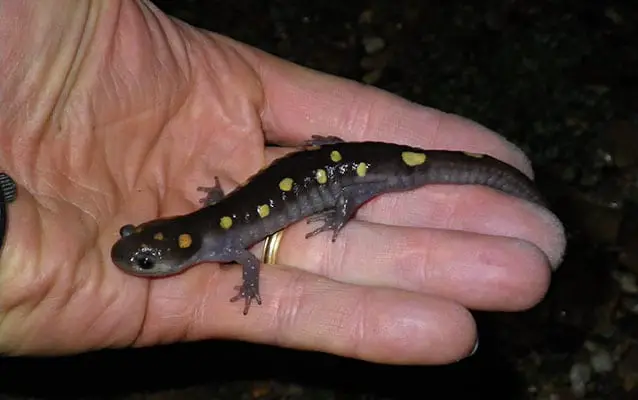
Cage
You can keep at least to Spotted Salamanders in one cage or tank about 10 to 20-gallon capacity. The number of salamanders added, the larger the housing should be. The cage should be equipped with an enclosure or at least a screen to keep them from escaping and so as to avoid pest infestations. Their housing should mimic their natural environment where there are logs, burrows, or hiding spots where they can spend most of their time and also place a basin where they can drink water.
Substrate and Accessories
For your pet to stay alive and healthy, make sure that their environment invites a good atmosphere where there are proper moisture and correct acidity level. To ensure that their place won’t be a breeding ground for bacteria and fungus. The substrate to use should be damp and thick enough so that they can still do their burrowing activity. The use of ground pine bark, ground peat moss, sphagnum moss or coconut mulch will also create a close-to-natural habitat for them.
Since it is preferred to use a damp substrate, make sure to completely change it in a month to avoid the propagation of different bacteria that may be a cause of different health conditions. If you would use accessories or furnishings, make sure that it doesn’t contain harmful chemicals or odors and it shouldn’t have sharp edges that may hurt your pet.
Lighting and Temperature
Spotted Salamanders are considered subterranean that requires little to no light exposure. If you would prefer to use lighting equipment, make sure that it does not emit heat, and it should only be for a few hours within the day. A comfortable environment for them has a temperature within 50 to 70-degree Fahrenheit which is quite cool. Always check the temperature level, make sure that it doesn’t reach 75 degrees Fahrenheit.
Food
A hungry Spotted Salamander is attracted to almost all moving creatures that they can overpower, which includes different kinds of insects. They tend to eat in large quantities in captivity, but it is only advisable to feed them at least three times a week. You can change the kind of food that you can give them every week like if you have given them worms this week, you can give them other insects next and so on.
Water
They do not drink water through their mouths like the traditional way, but they absorb water through their skin and cloaca that is why it is important to place a basin on their housing just enough to keep them hydrated. Change their water regularly to make sure it is always clean. If you notice that their substrate is drying up, just spray it with water.
Handling
They have a soft and delicate skin that is why it is important not to handle them too often. If in case you need to hold them, make sure to have clean and wet hands or as much as possible wear gloves so as not to transfer the oils and dirt in your hands into their skin. Also, in holding them, don’t press hard on their bodies so as not to stress them out.
Inspect their body
It is advisable to check the body of your pet at least once a month so that you could see possible signs of diseases or illness, especially skin problems. If you see any unusual changes in their body, take them to your veterinary so that they could check if it needs some treatment.
Availability – Where to Get One
Spotted Salamanders are still generally stable in terms of their population; that is why it is just easy to get one for captivity. They can be seen in different pet shops especially in the USA. Experts would recommend availing Spotted Salamanders from a US breed salamander rather than an Asian bred especially during online transactions because it is observed that Asian bred salamanders are the number one carrier of different common illnesses and diseases. They are priced cheaper compared to others taken into captivity such as lizards or snakes.
Some breeders who have it in captivity didn’t get it from a pet shop or from a pet collector but they personally hunt these reptiles in the wild. Sometimes, these hunters would aggressively get them posing some danger to their health especially when they get some wounds and bruises.
Predators and Threat to Their Survival
Even though Spotted Salamanders are not yet considered endangered, they are confronted with different situations that threaten their populations. One of which is their predators which include raccoons, turtles, snakes, skunks, and even humans. Some salamanders don’t even reach the hatching period their larvae are eaten by fish since they lay eggs in ponds or other bodies of water. You can often see them in bodies of water, due to climate change, the Ph level decreases or increases which is also harmful to them.
Another reason why they are threatened is because of the degradation of their natural environment due to forest fires, climate change, timber harvesting, etc. They are often seen on the roads where they are being hit by a running vehicle if you leave near their habitat and you see a Spotted Salamander crossing the road; you can help them by taking it to a safe place.
Fun Facts about Spotted Salamander
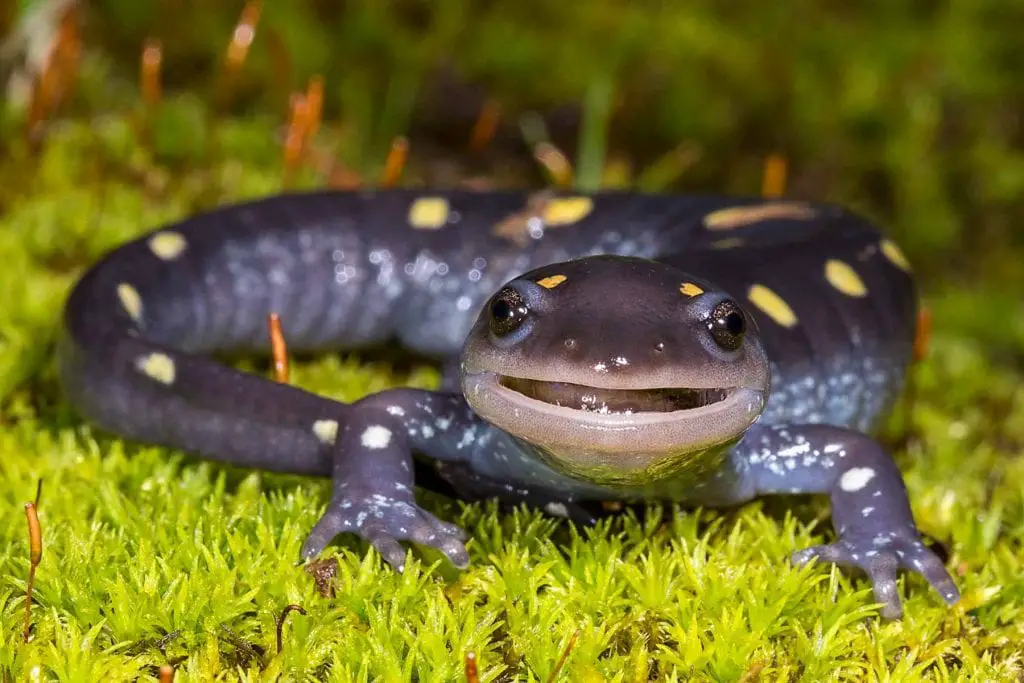
- As part of their defense mechanism, when they are threatened by a predator, they would drop their tail and escape. Dropping a part of their body doesn’t mind them because they have regenerative abilities even though it takes time for their bodies to fully recover.
- It takes about 90% of baby Spotted Salamanders to die even before they reach adulthood when they are left in the ponds because of their predators and due to the pond drying up.
- Females have the ability to lay at least 200 hundred eggs, and all of these can reach adulthood if there it is laid in freshwater without wildlife animals that prey on the eggs.
- They would prefer to hide when in danger, but if they are confronted with danger and there is no chance of escaping, they’ll release a poisonous substance that may harm their predator.
- They have bright spots that serve as a sign to predators that they can produce toxic chemicals in their heads and tails. The so-called chemicals that they release are not chemical that may harm the health of their predator, but it is just a way to threaten the.
- There are types of Spotted Salamander that don’t have spots, but they are only rare.
- There are salamanders that have four legs, 2 legs in front and 2 legs at the back while there are also salamanders that only have 2 legs which are in front.
- They are sexually immature until they reach their 2nd or 3rd year of life. They can only reproduce if they are living in an ideal environment with the ideal location, climate, and temperature. There are Spotted Salamanders that may take 5-7 years for them to be sexually mature for breeding.
FAQs
Is the spotted salamander poisonous to humans?
The “poisonous” substance it secretes is not literally poisonous it’s just that when a predator tastes it, it is so bitter that they don’t want to eat it. This secretion is not fatal to both humans and animals it is just one of their defensive mechanisms.
Are salamanders a good pet?
Salamanders are considered as a pet for beginners because they can be entertaining and rewarding. They are also appealing with their cute features and their ability to live long.
Do Spotted Salamanders bite?
They are considered as timid and mysterious animals. They are completely harmless if you won’t mishandle them. It is always advisable to always wash your hands before and after holding them because the glands found on their skin may cause irritations when they are transmitted to the human skin. Even though they are shy, if harmed, they may show some aggressiveness like biting, but it is not serious or fatal.
How do you take good care of a Spotted Salamander?
Taking good care of Spotted Salamander is not that complicated, you may need to follow guidelines but those are all basic. In captivity, just make sure that their housing is always clean and sanitized and be sure to feed them clean insects or other small living creatures.
Can you hold salamanders?
They have an absorbent and fragile skin. The oils and salt composition on the human hands can harm their skin as well that is why as much as possible, don’t hold them, you can still enjoy them by observing them through their housing.
What is the spiritual meaning of a salamander?
The salamander is an animal totem that has symbolic ties with the element of water. It is also closely related to renewal, awareness, emotions, and spirituality.
How often do you feed a salamander?
It is not advisable to feed them every day to avoid obesity and being overweight. They are usually fed at least three times a week. There are times that you could sense that they are hungry; it is just normal especially before and after shedding their skin but you should stick still stick to their usual eating pattern.
How do salamanders survive the harsh conditions of winter?
They have a very good adaptation or defense mechanism against the extreme weather conditions; once their skin gets in contact with ice crystals, their brain signals their liver to start converting glycogen to glucose (sugar) and then the blood will carry the antifreeze throughout the tissues and organs.
Do salamanders eat their own skin?
Yes, they eat their own skin during the shedding process to recycle the nutrients. Their skin is rich in protein and fiber that is also needed for their growth and development. Some breeders don’t even know that their pet shedding their skin because there are no traces left.
How long can a salamander survive without eating?
The Spotted Salamander can survive days without food, given that they are healthy and fit. They can cope at least 9 days of starvation. If you would live them in captivity without food, make sure that at least they have water so as to make them hydrated still.

